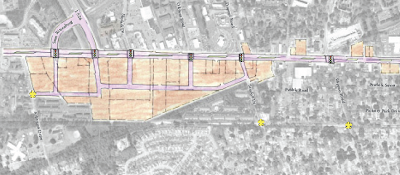Streetsblog DC has a great post about a rejected alternative to highway expansion in Charleston regarding a congested stretch of 4 lane suburban arterial. Read on:
The proposed secondary street grid would have been perpendicular and parallel to the existing arterial road.
To ease congestion on Savannah Highway, officials in Charleston have proposed an eight-mile, $489 million expansion of Interstate 526 through the towns of West Ashley, Johns Island and James Island.
One plan SC DOT rejected was developed by the Coastal Conservation League. The League opposes the I-526 extension, saying the project will destroy wetlands and perpetuate sprawl while having no effect on congestion on Savannah Highway. Their alternative proposal, “A New Way to Work,” could serve as a model for how to improve safety and make communities more livable while avoiding the expense and sprawl caused highway expansion.
“A New Way to Work” asserts that the congestion problems on Savannah Highway can be solved through street-level interventions in key locations. The biggest shortcoming of Savannah Highway, say League staff, is poor design. Their report notes that the road has a driveway every 80 feet, on average, creating a chaotic scramble between drivers who use the road to travel far distances and those who dash in and out of retail establishments. The lack of connectivity in the street network also limits drivers’ options, forcing traffic onto the arterial road.
What is needed, the report states, is a hierarchy of streets for different types of trips.
In its proposed redesign of Savannah Highway, the League would:
These three principles are recommended by the Transportation Research Board to reduce congestion, preserve scenic landscapes and improve safety of motorists and pedestrians.
- Eliminate many curb cuts
- Install medians to control turning
- Repair connections between cul-de-sac-style, disconnected streets
“It centers around the power of the network streets to relieve the knots in the system,” said the League’s Josh Martin. “We’re trying to create a really great, livable, walkable multi-modal street.”
Sigh.

No comments:
Post a Comment